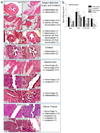Chlamydial protease-like activity factor mediated protection against C. trachomatis in guinea pigs
- PMID: 27990018
- PMCID: PMC5449249
- DOI: 10.1038/icb.2016.122
Chlamydial protease-like activity factor mediated protection against C. trachomatis in guinea pigs
Abstract
We have comprehensively demonstrated using the mouse model that intranasal immunization with recombinant chlamydial protease-like activity factor (rCPAF) leads to a significant reduction in bacterial burden, genital tract pathology and preserves fertility following intravaginal genital chlamydial challenge. In the present report, we evaluated the protective efficacy of rCPAF immunization in guinea pigs, a second animal model for genital chlamydial infection. Using a vaccination strategy similar to the mouse model, we intranasally immunized female guinea pigs with rCPAF plus CpG deoxynucleotides (CpG; as an adjuvant), and challenged intravaginally with C. trachomatis serovar D (CT-D). Immunization with rCPAF/CpG significantly reduced vaginal CT-D shedding and induced resolution of infection by day 24, compared with day 33 in CpG alone treated and challenged animals. Immunization induced robust anti-rCPAF serum IgG 2 weeks following the last immunization, and was sustained at a high-level 4 weeks post challenge. Upregulation of antigen-specific IFN-γ gene expression was observed in rCPAF/CpG-vaccinated splenocytes. Importantly, a significant reduction in inflammation in the genital tissue in rCPAF/CpG-immunized guinea pigs compared with CpG-immunized animals was observed. Taken together, this study provides evidence of the protective efficacy of rCPAF as a vaccine candidate in a second animal model of genital chlamydial infection.
Conflict of interest statement
Figures




Similar articles
-
Intranasal immunization with recombinant chlamydial protease-like activity factor attenuates atherosclerotic pathology following Chlamydia pneumoniae infection in mice.Immunol Cell Biol. 2019 Jan;97(1):85-91. doi: 10.1111/imcb.12192. Epub 2018 Aug 23. Immunol Cell Biol. 2019. PMID: 30051926 Free PMC article.
-
Intranasal vaccination with a secreted chlamydial protein enhances resolution of genital Chlamydia muridarum infection, protects against oviduct pathology, and is highly dependent upon endogenous gamma interferon production.Infect Immun. 2007 Feb;75(2):666-76. doi: 10.1128/IAI.01280-06. Epub 2006 Nov 21. Infect Immun. 2007. PMID: 17118987 Free PMC article.
-
Induction of cross-serovar protection against genital chlamydial infection by a targeted multisubunit vaccination approach.Clin Vaccine Immunol. 2007 Dec;14(12):1537-44. doi: 10.1128/CVI.00274-07. Epub 2007 Oct 17. Clin Vaccine Immunol. 2007. PMID: 17942608 Free PMC article.
-
Heat denatured enzymatically inactive recombinant chlamydial protease-like activity factor induces robust protective immunity against genital chlamydial challenge.Vaccine. 2010 Mar 8;28(11):2323-9. doi: 10.1016/j.vaccine.2009.12.064. Epub 2010 Jan 5. Vaccine. 2010. PMID: 20056182 Free PMC article.
-
Intranasal immunization with chlamydial protease-like activity factor and CpG deoxynucleotides enhances protective immunity against genital Chlamydia muridarum infection.Vaccine. 2007 May 10;25(19):3773-80. doi: 10.1016/j.vaccine.2007.02.010. Epub 2007 Feb 23. Vaccine. 2007. PMID: 17349723 Free PMC article.
Cited by
-
The effect of infectious dose on humoral and cellular immune responses in Chlamydophila caviae primary ocular infection.PLoS One. 2017 Jul 5;12(7):e0180551. doi: 10.1371/journal.pone.0180551. eCollection 2017. PLoS One. 2017. PMID: 28678871 Free PMC article.
-
Chlamydia trachomatis vaccines for genital infections: where are we and how far is there to go?Expert Rev Vaccines. 2021 Apr;20(4):421-435. doi: 10.1080/14760584.2021.1899817. Epub 2021 Apr 28. Expert Rev Vaccines. 2021. PMID: 33682583 Free PMC article.
-
Study Models for Chlamydia trachomatis Infection of the Female Reproductive Tract.Microorganisms. 2025 Feb 28;13(3):553. doi: 10.3390/microorganisms13030553. Microorganisms. 2025. PMID: 40142446 Free PMC article. Review.
-
Intranasal immunization with recombinant chlamydial protease-like activity factor attenuates atherosclerotic pathology following Chlamydia pneumoniae infection in mice.Immunol Cell Biol. 2019 Jan;97(1):85-91. doi: 10.1111/imcb.12192. Epub 2018 Aug 23. Immunol Cell Biol. 2019. PMID: 30051926 Free PMC article.
References
-
- Brunham RC, Rey-Ladino J. Immunology of Chlamydia infection: implications for a Chlamydia trachomatis vaccine. Nature reviews. Immunology. 2005;5(2):149–161. - PubMed
-
- Hafner LM. Pathogenesis of fallopian tube damage caused by Chlamydia trachomatis infections. Contraception. 2015;92(2):108–115. - PubMed
Publication types
MeSH terms
Substances
Grants and funding
LinkOut - more resources
Full Text Sources
Other Literature Sources
Medical

